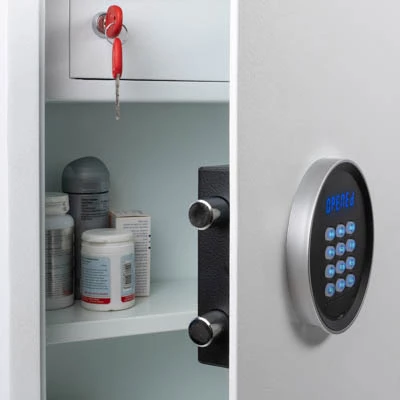Controlling Drugs in Care Homes
February 23, 2025

Controlling Drugs: In care homes, managing medication is a crucial part of patient care. Improper handling can lead to serious consequences. This article highlights the importance of drug control in care homes. It focuses on the role of medical cabinets. Ensuring the safety and well-being of residents depends on precise and careful management.

Introduction of Controlling Drugs in Care Homes
Care homes provide care for vulnerable individuals, often including the elderly, those with disabilities, and people with chronic conditions. These individuals may require multiple medications daily. Ensuring the safe storage, administration, and disposal of drugs is essential for their health and safety. Drugs, if mishandled, pose risks such as overdoses, misuse, or accidental harm.
Why Controlling Drugs Is Crucial in Care Homes
Drug control is vital for several reasons. First, it ensures that the correct medication is administered in the correct dosage. Errors in administration can lead to adverse reactions. Second, proper drug control prevents misuse. Care home staff must be vigilant about who has access to medications, particularly controlled substances.
Legal and Ethical Obligations
Care homes are legally bound to adhere to regulations governing drug storage and administration. In many countries, these laws are stringent to protect vulnerable individuals. Care homes must comply with national health and safety standards. These standards include clear guidelines for the storage and management of medications.
Ethically, care homes have a duty of care to protect residents from harm. This duty extends to all aspects of their care, including medication management. Ensuring that drugs are safely stored and properly administered is a fundamental responsibility.
The Role of Medical Cabinets in Controlling Drugs
Medical cabinets are designed to securely store medications, ensuring that they are safe from tampering, theft, or misuse. These cabinets must meet specific standards for security and accessibility. Depending on the regulations in the area, some medications, especially controlled substances, may require a higher level of security.
Medical cabinets should be located in a controlled environment within the care home. They should be locked when not in use, with access limited to authorized personnel only. This prevents unauthorized individuals from gaining access to medication and helps ensure that drugs are administered according to protocol.
Types of Medications Requiring Special Control
In care homes, some drugs require special attention due to their potential for misuse or severe side effects. Opioids, sedatives, and other controlled substances are particularly risky. These medications should be stored in cabinets with extra security features, such as dual-locking mechanisms or electronic access controls.
Other medications, such as those for diabetes or heart conditions, must be stored correctly. Proper storage maintains their effectiveness in addition to controlled substances. Improper storage can alter their chemical properties, making them ineffective or unsafe.
The Importance of Accurate Record-Keeping
Effective drug control is not limited to physical storage. Accurate record-keeping is essential. Staff must document the administration of medications, noting the type, dosage, and time given. This creates a clear history of what has been administered to each resident.
Records are also important for ensuring that medications are replenished when needed. A thorough record allows care homes to manage drug stocks efficiently, preventing shortages or stockpiling of medications.
Staff Training and Awareness
Proper staff training is crucial for effective drug control. All personnel involved in medication administration must understand the procedures and regulations. They must also be familiar with the potential side effects and risks of the drugs they are handling.
Regular training and audits help ensure that staff stay updated on best practices for drug management. This reduces the risk of human error, which is a common cause of medication mistakes.

Security Measures Beyond Medical Cabinets
While medical cabinets are an essential tool for drug control, additional security measures are necessary. These may include monitoring systems that track who accesses the cabinets and when. Video surveillance in medication storage areas can also act as a deterrent to potential misuse.
Care homes may also consider using automated dispensing systems that control the amount and type of medication dispensed. These systems can be programmed to release only the prescribed dosage, preventing overmedication.
Addressing the Risks of Drug Misuse and Abuse
While drug misuse is a significant concern, the potential for abuse is also a risk in care homes. Residents themselves may misuse their medications, especially if they are living with conditions such as dementia. Family members or other visitors may also pose a risk by attempting to steal medications.
To combat this, care homes should adopt strict visitor policies and monitor residents’ use of medications. Encouraging open communication between care staff and families about medication needs can help mitigate this risk.
The Impact of Proper Drug Control on Residents’ Well-being
Controlling Drugs: In care homes, managing medication is a crucial part of patient care. Improper handling can lead to serious consequences.Effective drug control directly affects the well-being of care home residents. It ensures that they receive the correct medications on time, preventing pain, discomfort, or exacerbation of medical conditions. This contributes to better health outcomes and improves the quality of life for residents.
Proper medication management can also reduce the incidence of hospital readmissions. Care homes can lower the risk of emergencies that require hospitalization by keeping residents stable. They ensure their health is properly monitored.
Challenges in Implementing Controlling Drugs
Despite its importance, implementing drug control in care homes comes with challenges. First, the sheer volume of medications required by residents can be overwhelming. Care homes must balance the need for proper medication with the constraints of space and staff availability.
Moreover, evolving regulations and policies can make it difficult for care homes to stay compliant. Regular updates to drug control procedures and systems are essential, but they can be resource-intensive.
Technological Advancements in Controlling Drugs
Technology is playing an increasingly important role in improving drug control in care homes. From automated medication dispensing systems to electronic health records, these innovations streamline the medication management process.
By integrating technology, care homes can improve accuracy, reduce errors, and enhance overall security. Smart systems track medication usage. They also automate dispensing. This ensures that staff can focus on delivering quality care instead of administrative tasks.
Conclusion: Ensuring Safe Medication Practices in Care Homes
In conclusion, controlling drugs in care homes is essential to protect the health and safety of residents. Proper medication management, secure storage solutions, accurate record-keeping, and staff training all play a vital role. Medical cabinets are a critical component of this system, offering secure storage for potentially dangerous medications.
Care homes can ensure that residents receive the care they need by implementing robust systems. They foster a culture of safety and compliance. This way, the risks associated with medication mishandling are avoided. With a continued focus on training, care homes can enhance medication management. They can also provide a safer environment with improved security and technology for all residents.
Discover more from Blog Total Locker Service
Subscribe to get the latest posts sent to your email.